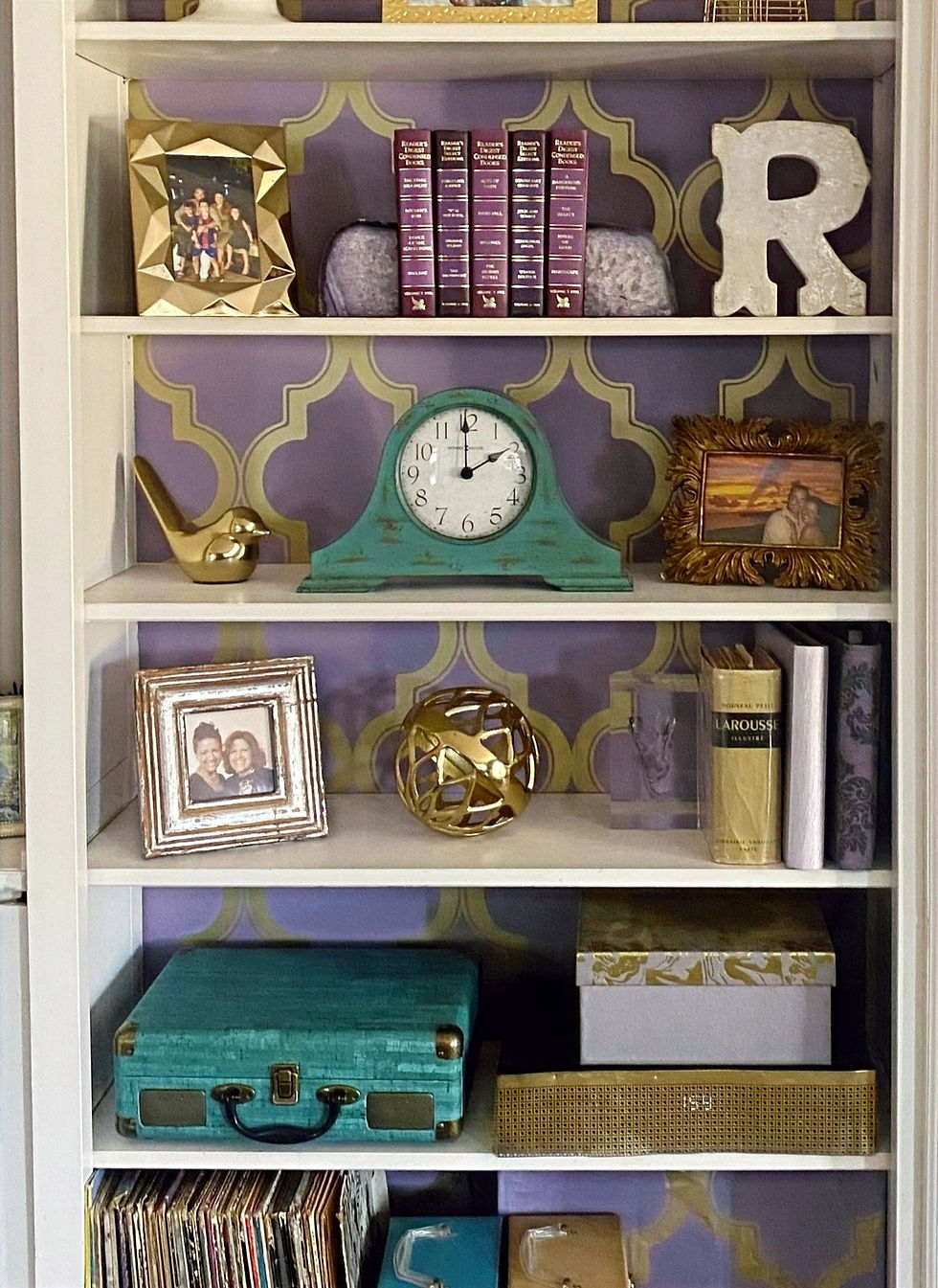How to Hide a Cable Box and Other Household Electronics
- Erin

- Apr 6, 2023
- 3 min read
Updated: May 3, 2023
As mentioned in my previous post, my bookshelves have turned into eyesores, and after hours of rearranging everything on them, I realized what the problem was: the ugly cable box, router and wires. They are necessary items, and after a while you tend to stop seeing them. However, once I began restyling my shelves by updating some of the decorative objects and reducing clutter, I decided the ugly electronics had to go. Obviously I couldn't actually get rid of them, so I decided to hide them instead.

How To Hide a Cable Box
The first thing i wanted to do was hide the cable box. When thinking of ideas on how to hide a cable box, keep in mind that it still needed to be exposed enough for the remote to work, so whatever is covering it can't be completely solid. I found a decorative piece of sheet metal in my basement, but you can purchase a wide variety of them at any hardware store or Amazon.

The first step is to trim the metal to size. The height should be about an eighth to a quarter of an inch higher than the box. The length depends on where your cable box is, and if the sides are exposed. If they are, then you will want enough to cover the length of the front and both sides. If only the front is visible (as is mine) the length should be at least two inches longer on each side.
Although you can buy the sheet metal in a variety of colors, the piece I happened to have already was black, so I covered it with a layer of metallic gold spray paint.


Once it was dry, I bent the edges at a 90 degree angle to wrap around the front of the box.

Lastly, I simply slid it into place around the cable box - and yes, the remote still works!

I added a decorative box on top to further conceal it, and give the look of stacked boxes.

I knew I'd get complaints about the clock on the cable box being covered, so I added a vintage style clock to the bookshelf to display the time (and force my kids to read analog time).

HIDDEN WI-FI ROUTER
I had some decorative photo albums that I purchased a few years ago because they matched my decor, but I never got around to putting actual photos in them. You can use any hardcover book for this, but as I wasn't using the albums anyway, I decided to use one to hide the router.

I used an X-acto knife to remove the inside pages from the spine of the book so I only had the cover remaining.

I took the remaining cover of the book and placed it over the router. Because the router needs to emit a signal, I made sure to leave a bit of space between it and the book cover.

I placed a couple of additional books next to it, and now it just looks like books on a shelf and blends in seamlessly!

HIDING UNSIGHTLY WIRES
Because my shelves are built in, I can't get the wires behind the wall, so instead I came up with a way to put the wall in front of the wires. It sounds difficult, but this is quite possibly the easiest and simplest way to hide wires and cables!
I grabbed an old cardboard box and cut it to the same height and width as the shelf back. Using the same wallpaper I used to line the back of the bookcases, I simply wrapped a piece of cardboard in the wallpaper. If your shelves are not wallpapered just paint the cardboard the same color as the shelves.

I placed the wallpaper covered cardboard in front of the wires and voila - a false shelf back!

HIDDEN RECORD PLAYER
I have all my mom's old records, and for obvious reasons they have a lot of sentimental value. The experience of sliding the record out from the sleeve, reading my mom's handwritten notes on it, placing it on the turntable, setting the needle on the groove, and then hearing that distinctive crackle brings back a flood of happy memories every time.

The record player itself though is another story. It's a bit of an eyesore, along with being super annoying to dust with all the parts exposed.

I found a super cute, affordable HIDDEN record player on Amazon for only $39!

The lid opens to reveal a complete record player with built in speakers. When closed, it looks like a little vintage suitcase that looks great with my mom's old cases for her 45's.






If you're wondering how to tell time on a clock with hands, especially if you're teaching a child, interactive online tools can be a fantastic resource. These virtual clocks often allow you to manipulate the hands, see the corresponding digital time, and sometimes even offer little games or challenges to practice reading the clock. It makes the learning process much more hands-on and visual, which is often more effective for kids than just explanations. It’s a great way to build that foundational skill in a playful way.
An analog clock for kids that they can actually interact with is a game-changer for learning. Many online versions allow children to drag the minute and hour hands to set different times, or they might show a time and ask the child to set the hands correctly. This hands-on practice is invaluable. Some even have features like showing elapsed time or different clock faces. It’s a fantastic educational tool that leverages technology to teach a traditional skill in a more engaging and effective manner, making it less daunting for young learners.
Add style and function to your devices with a pink 3.5 mm audio cable.